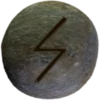Last Updated on February 14, 2025


Skögul (SKOH-gool) stands among the most powerful Valkyries in Norse mythology. Some texts spell her name as Skogul or Skögull. The Poetic Edda and the Prose Edda mention her as a battle maiden who serves Odin. She chooses which warriors die and which survive. ![]()
Valkyries, including Skögul, ride through battlefields, clad in shining armor. They wield spears and shields, striking terror into their enemies. Skögul’s name means “shaker” or “high-tumult,” fitting her role as a bringer of war’s chaos. Some sources list her alongside other Valkyries, emphasizing her importance.
The Völsunga saga names her as one of Odin’s chosen. She guides slain heroes to Valhalla, where they prepare for Ragnarök. The Hákonarmál, a skaldic poem, describes her and Göndul escorting a fallen king to Odin’s hall. This tale highlights her duty in honoring great warriors.
Skögul does more than claim the dead. Some believe she influences battle strategies, whispering to rulers and generals. Her presence on the battlefield ensures Odin’s will takes shape. Unlike some Valkyries, who act as lovers or guardians, Skögul embodies the raw force of war.
She often appears alongside Göndul (GON-dool), another fierce Valkyrie. Together, they decide fates with precision. Some scholars suggest Skögul may be another name for Göndul or a title for high-ranking Valkyries.
Legends depict Valkyries as supernatural, yet some warriors bore their names. This suggests admiration and a desire to channel their strength. The image of Skögul, spear in hand, leading warriors to glory, persists in Norse culture.
Even today, Skögul symbolizes bravery, fate, and the honor of a warrior’s death. Her legacy endures through literature, art, and modern interpretations of Norse mythology.
Runes of Skögul
Two Elder Futhark runes connect to Skögul: Tiwaz (ᛏ) and Sowilō (ᛊ). Tiwaz represents Týr, the god of justice and war. It signifies leadership, strategy, and sacrifice—qualities essential to Skögul’s role.
Sowilō means “sun” and represents victory, power, and guidance. It embodies the light that leads warriors to their fate, just as Skögul does. She ensures the worthy ascend to Valhalla, much like the sun’s guiding force.
These runes reflect her essence as a chooser of the slain and a force of battle. ![]()
Her Role in Asatru
Asatruar honor Skögul as a powerful force of fate and battle. She reminds them of courage, sacrifice, and destiny. Warriors and those seeking strength look to her for inspiration.
Some see her as a guide in life’s struggles, pushing them toward personal victory. She represents the honor of facing challenges head-on. Her connection to Odin ties her to wisdom and leadership.
Asatruar view Skögul as more than a warrior. She shapes fate and ensures the brave earn their place in the afterlife. Her presence reinforces the belief in an honorable end.
